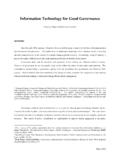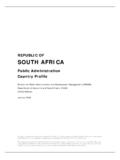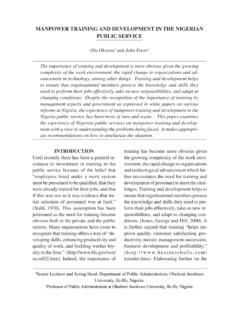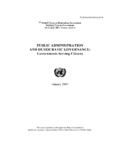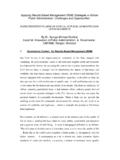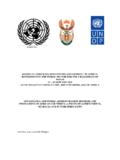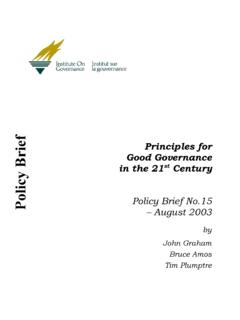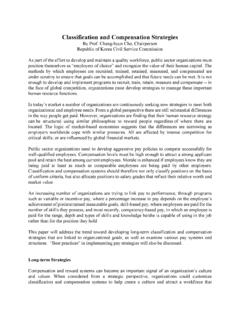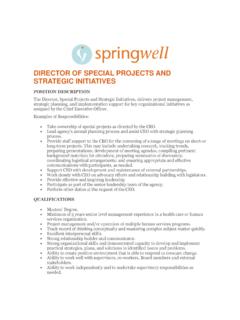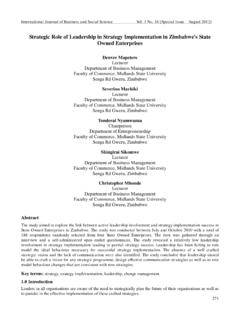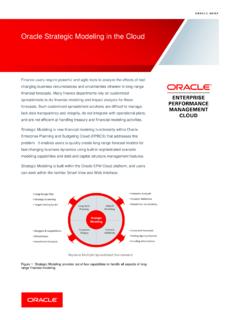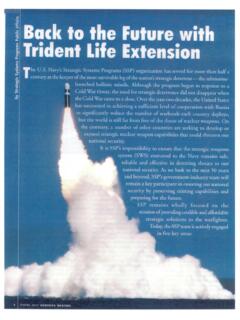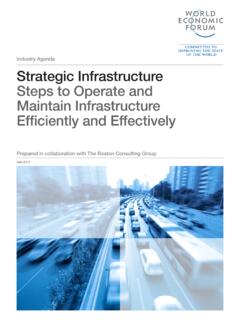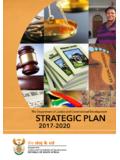Transcription of A STRATEGIC FRAMEWORK FOR GENDER EQUALITY …
1 A STRATEGIC FRAMEWORK . FOR GENDER EQUALITY . within THE PUBLIC SERVICE. (2006-2015). Consultation Document Together beating the drum for service delivery . CONTENTS. Foreword i. Introduction 02. II. Context 03. III. Key challenges facing Women 04. iv, GENDER Equity in the Public Service: Situational Analysis 07. v. The Objectives of the STRATEGIC FRAMEWORK 09. vi. Principles and Guidelines underpinning the FRAMEWORK 11. vii. STRATEGIC Approach to Women's Empowerment and GENDER EQUALITY within the Public Service 14. viii. Strategy of GENDER Mainstreaming 15. ix. Implementation Plan 18. x. Communication and Consultation 22.
2 Xi. Glossary of Terms 26. xii. References 29. 1. INTRODUCTION. This STRATEGIC FRAMEWORK for GENDER EQUALITY within the Public Service (2006-2015). is aimed at achieving women's empowerment and GENDER EQUALITY in the workplace. Additionally, it is aimed at ensuring a better quality of life for all women through improved and accelerated service delivery by the Public Service. It is premised on the promotion and protection of human dignity and human rights of women, including the rights of women with disabilities. It takes cognizance of the role of institutions in promoting non-sexism and non-racialism, particularly issues pertaining to organizational transformation and change and how these changes are managed within the context of a transforming and developing State.
3 It is within this context of transformation and development that the STRATEGIC FRAMEWORK projects with renewed vigour the goal of achieving women's empowerment and GENDER EQUALITY , including that of a new profile for the Public Service. While the FRAMEWORK incorporates a strategy geared towards increasing the number of women at all levels of the Senior Management Service (SMS), it goes beyond just numbers to include the element of empowerment, development and leadership of all women. The approach taken towards the integration of GENDER into the day-to-day work of the Public Service is based on government's national priority areas.
4 Government has identified the following priority areas with the central theme of accelerating change to improve the quality of life of the people both in rural and urban areas: Reduce poverty and unemployment by half by 2014;. Provide the skills required by the economy;. Consolidate democracy and build a caring and responsive state;. Combat crime and corruption;. A better national health profile; and 2. Public Sector Project : A STRATEGIC FRAMEWORK for GENDER EQUALITY within the Public Service (2006 2015). Play a progressive role in Africa and the world. The priority focus on increasing women's participation in decision-making, and the concomitant adoption of the Public Service employment equity target of 50%.
5 Representation for women at all levels of the SMS, are built into the current strategy. This translates to a concerted effort needed across all government departments, at national, provincial and local levels, in addressing women's empowerment and leadership development. The FRAMEWORK proposes a process that moves away from treating GENDER issues as business as usual , towards locating it at the very center of the transformation process in the Public Sector. Achieving the goal of GENDER EQUALITY is therefore premised on the fundamental integration of women and GENDER issues within all structures, institutions, policies, procedures, practice, programmes and projects of government.
6 2. Context In his Inaugural Address in 1994, President Mandela noted that genuine liberation in our country would not be achieved unless we see in visible and practical terms that the condition of women in our country has radically changed for the better and that they have been empowered to intervene in all spheres of life as equals with any member of our society.. This political commitment to women's empowerment and GENDER EQUALITY is enshrined in the South African Constitution, Act 108 of 1996 and its Bill of Rights. It is expressed as the transformation of the State into a genuinely non-sexist and non- racist society.
7 The ensuing years since the advent of democracy have shown much progress in the status of women in the country. There has been considerable increase in the representation and participation of women in public life, particularly in the labour force, guaranteed by a forward-looking legislative FRAMEWORK , including the Public Service Act of 1994, the White Paper on the Transformation of the Public Service, 3. Public Sector Project : A STRATEGIC FRAMEWORK for GENDER EQUALITY within the Public Service (2006 2015). 1995; the Employment Equity Act, 1998; and the Promotion and Prevention of Unfair Discrimination Act 4 of 2000. In 1997, the SADC Heads of States' Declaration on GENDER and Development set a minimum target of 30% women in decision-making positions for SADC Member States by 2005, to which South Africa was a signatory.
8 In line with this, in 2003, Cabinet adopted the minimum target of 30% women in the Public Service, and which is also contained in the White Paper for the Transformation of the Public Service, 1995. In His State of the Nation address in 2005, President Mbeki, emphasised that the capacity and organisation of the State was critical to the achievement of nationally identified priorities. In this regard, President Mbeki renewed government's commitment to the principles of employment equity and the goal of making the Public Service a truly representative and inclusive national institution. This was reinforced in the 2005 Budget Vote Speech by Ms.
9 Geraldine J Fraser-Moleketi, Minister for Public Service and Administration. Further, in 2005, SADC Heads of State reviewed the minimum 30% target and aligned with the African Union (AU) target of 50% women in decision-making positions, as outlined in the 2004 AU Heads of States' Solemn declaration on GENDER EQUALITY in Africa, to which South African is a signatory. On 30 November 2005, Cabinet adopted a revised employment equity target of 50%. women at all levels in the SMS by 31 March 2009 (Cabinet Memo 86A of 2005, dated 30 November 2005, file number CM 86A/2005). In addition, Cabinet also supported the development of a GENDER and Governance plan of action that would ensure substantial progress is made on women's empowerment and GENDER EQUALITY in the Public Service.
10 4. Public Sector Project : A STRATEGIC FRAMEWORK for GENDER EQUALITY within the Public Service (2006 2015). 3. KEY CHALLENGES FACING WOMEN. An analysis of the 12 years of democratic governance indicates that while considerable progress has been made with regard to institutionalising women's rights and GENDER EQUALITY , South Africa still faces many challenges. To achieve a society free of racism and sexism, the country must undergo a paradigm shift with regard to the way in which resources are allocated and how people relate to each other. These challenges which face the country have been translated into national priorities.
